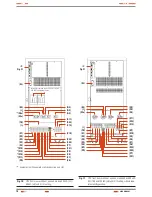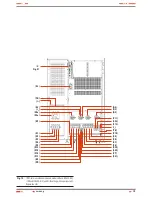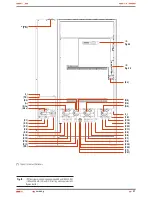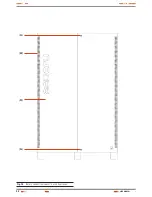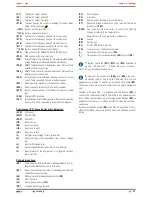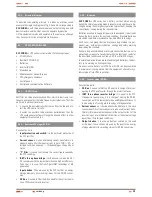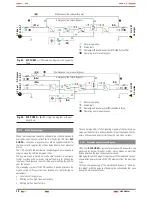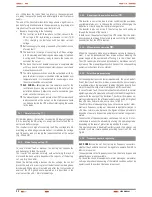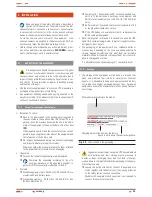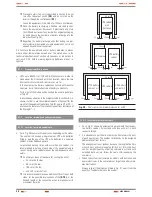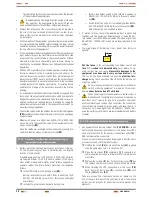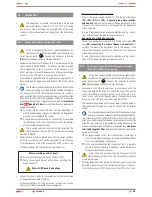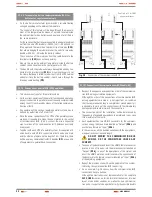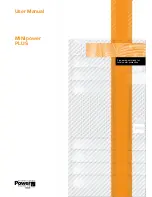
32
etc...). Whatever the type of load to protect is, these equipments
are ready to assure the quality and uninterruptible electrical power
supply.
The use of the transformerless technology allows a significant re-
duction of weight and volume in the equipments, by improving a lot
important coefficients like the power/footprint ratio.
• Basically its operating is the following:
The rectifier, an IGBT three phase rectifier, converts the
AC voltage in DC by draining a sinewave current (THDi
<2%), charging the batteries with constant current/
voltage.
Batteries supply the energy required by the inverter in case
of mains fault.
The inverter is in charge of converting the DC bus voltage
into AC providing an alternating sinewave output, stabilised
in voltage and frequency, ready to supply the loads con-
nected at the output.
The basic structure of double conversion is complemented
with two new functional stages, static bypass switch and
manual bypass switch.
The static bypass switch connects the output load with by-
pass line directly in special conditions like overload or over
temperature and it is reconnected to inverter again, once
the normal conditions are restored.
SLC CUBE3+ B
version has two separate lines for the
rectifier and bypass stages increasing in the safety of the
installation, because it allows the use of a second line (gen-
erator set, other company, etc...).
The manual bypass switch isolates the UPS from mains and
loads connected at the output, so the maintenance tasks
can be done inside the UPS without interrupting the supply
to the loads.
4.4.1. Normal operating (
).
With mains present, the rectifier converts the AC input voltage into
DC, by boosting the DC voltage to an optimal level to feed the in-
verter and battery charger.
The inverter is in charge of converting the DC bus voltage into AC
providing an alternating sinewave output, it stabilises the voltage
and frequency, ready to supply the loads connected at the output
(Fig. 25 and 26).
4.4.2. Mains fault operating (
).
In case of mains fault or blackout, the battery set supplies the
needed energy to feed the inverter.
The inverter still operates normally, without noticing the lack of
mains and the back up time depends in the capacity of the battery
set only (Fig. 25 and 26).
When the battery voltage reaches the low voltage, the control
blocks the output in order to protect the batteries from being deep
discharged. When mains is restored and after the first seconds of
analysis, the UPS goes back to operate as it is described in the
previous section «4.4.1. Normal operating».
4.4.3. Operating with non-active inverter (
).
The inverter is non-active due to alarm conditions like overloads,
over temperatures, etc... In this case the rectifier is still charging the
batteries in order to keep their optimal charge status.
The inverter is also non-active if the start up has not been done
through the keypad of the control.
In both cases, the output voltage of the UPS comes from the emer-
gency bypass line through the static bypass switch (Fig. 25 and 26),
on condition that the EPO is inactive.
4.4.4. Manual bypass operating (
).
When it is required to make any maintenance service to the equip-
ment, it can be disconnected from mains without breaking the
power supply of the system and affecting it to the critical load.
The UPS can only be intervened by technical or maintenance staff,
by means of the manual bypass switch (respect the corresponding
operative instructions later on stated).
4.4.5. Smart Eco-mode operating.
For those applications with lower requirements, the smart and ef-
ficient function «Smart Eco-mode», meanwhile the power supply
is available, allows the equipment feeding the loads directly from
mains through the solid state static bypass («Off Line» mode).
In case of mains fault, the system will automatically shift to normal
operating mode («On Line») and will supply the loads through the in-
verter with the energy of the batteries. The «Smart Eco-mode» op-
erating mode improve the efficiencies between 4 and 4,5 % highest
than «On Line» normal mode, so it is close to 100 %.
The «Smart Eco-mode» operating does not ensure a perfect stabi-
lisation in frequency, voltage or sinewave shape (distortion) as in
«On Line» normal mode, because the figures of these parameters
depend on the static bypass line and preset activation ranges com-
pletely.
The detection of these parameters can take up to 3 ms, so it is rec-
ommended to assess the advisability of using this operating mode,
depending on the level of protection required by the loads.
This operating mode is disabled from factory and the end/user can
activate it, in case it were needed, according to section 7.3.2. and
Fig. 45.
4.4.6. Frequency converter operating.
SLC CUBE3+
can be set from factory as frequency converters,
whether they has batteries or not, being able to operate from 50 to
60 Hz or vice versa.
The equipments set as frequency converters, the static bypass and
manual bypass are not available.
So, those functions, measurements, alarm messages, parameter
settings, as well as manoeuvring of the related switches will not be
operative and they will not be taken into account.
USER MANUAL

